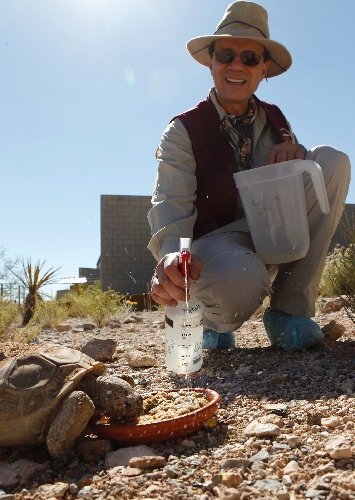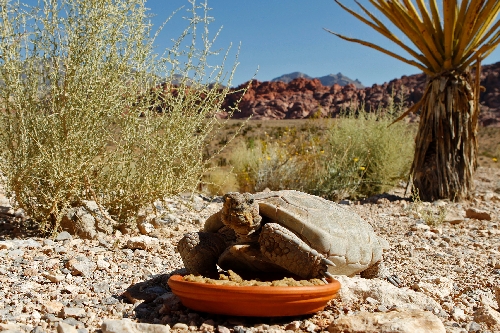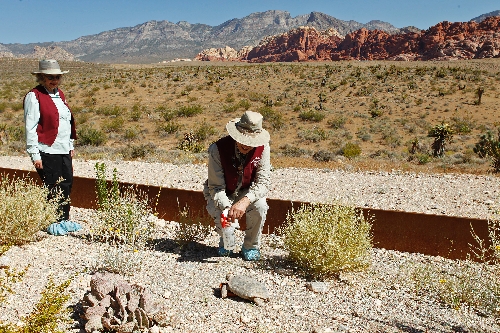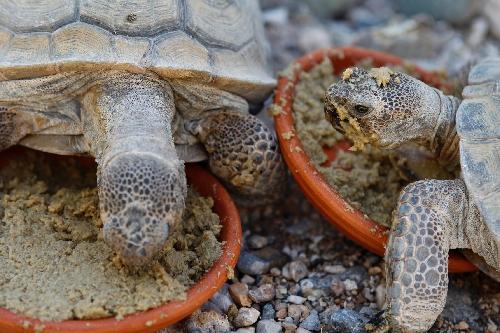Tortoise wrangling more than a hobby for Red Rock Canyon volunteers
They're animals from the wild but because they were once pets, they are unable to fend for themselves. So the tortoises at the Red Rock Canyon National Conservation Area Visitor Center are tended to by volunteers. They're tortoise habitat monitors, coordinated by Friends of Red Rock Canyon, a nonprofit group that helps care for the conservation area.
There are as many as 65 volunteers on the roster, said Roger Kolar, who, along with his wife, Susan, oversees the effort for the Bureau of Land Management and Friends. But there are only 18 core volunteers.
"People sometimes decide that the job isn't for them or they are just no longer in a position to volunteer," said Roger Kolar. "Tortoise wrangling may not be for everyone."
Volunteering at the habitat, established in 1995, is a hot-weather commitment. Tortoises come out of brumation, a semi-hibernation state, in March or April as the weather warms up. The animals are active until about October.
The tortoise program is administered through a partnership between the BLM and the U.S. Fish and Wildlife Service, with the San Diego Zoo consulting on the animals' care.
Besides caring for the animals, habitat monitors answer visitors' questions : Do the tortoises eat meat? (no, they're vegetarians); Are they amphibians? (no); Are they mammals or reptiles? (they're reptiles); and Are they being fed Puppy Chow? (no, it's a special formula to ensure that they get proper nutrition).
Cam Camburn, a Summerlin resident, has been volunteering at Red Rock Canyon since 2005 and began as a tortoise habitat monitor about two years ago.
"In winter, the main question you get is, 'Where are they?' " she said. "Of course that gets into a discussion of brumation, and that's an important distinction to make (from hibernation)."
When mammals hibernate, they are actually asleep. When reptiles brumate, they are less active and their metabolism slows so they do not need to eat as often.
Many times, Camburn said, she's educating locals who have their own tortoise and who may be feeding them foods with limited nutritional value and not ensuring that they have burrows.
"Some of them keep them in a closet for the winter, thinking that's sufficient," she said.
To avoid contamination, volunteers wear blue, surgical-type booties every time they step into the habitat. The volunteers also wear gloves, or they can opt to use hand sanitizer.
There are nine tortoises there. Lucie weighs just over 5 pounds. She's at least 40 years old.
Maxine, though the same age, is the largest. She tips the scales at 14 pounds.
The tortoises are fed twice a week -- Wednesdays and Saturdays. Habitat monitors count out their green kibble. Maxine, for example, gets 75 a feeding. Others may get about 20.
"We have to soak the kibble first because they won't eat it dry," said Cheryl Stereff, a Summerlin-area resident who began volunteering this spring. "We use a spray bottle to keep it moist because it dries out so fast."
Maxine owes her large size, in part, to stealing others' food. The volunteers have learned to feed her first so she's preoccupied.
Even with being fed, the animals still crunch on any vegetation within the habitat walls.
"They've eaten cactus down to the ground," said Susan Kolar.
Feeding and clean up duties can take up to two hours. And, yes, volunteers work as the pooper scoopers of the habitat.
Stereff recalled the training she underwent.
"At first, it was a little intimidating because there's so much to learn and all the steps you take," she said. "But it's a fascinating experience ... they relax me ... it's a contemplative thing."
About twice a month the animals get "soaked," where they are set in their individual tubs filled with water up to the bottom of their shells. This encourages them to drink water, which has health benefits such as helping them with digestion and avoiding bladder stones.
"And the tortoises seem to enjoy it," said Roger Kolar.
The pampered animals are accustomed to human interaction and will stand atop the volunteers' shoes. The verdict is out on whether it's a sign of affection or if it just means they want shade. But it does speak to the animals' comfort level around people.
"In the wild, they would do everything in their power to get away from you," said Roger Kolar.
They'll also hiss a warning if irritated.
While the tortoises might want to dig their way out of the habitat, two things prevent that -- the rock-like caliche that's the dirge of any pool builder in the valley and the cement block foundation of the habitat's retaining wall. One tortoise, Libby, wanted to extend a burrow. Rocks were set in the end to discourage her, but she dug underneath them. Bad move.
The rocks collapsed the tunnel, and she was trapped. No one could locate her for about 12 days.
"We thought she'd been stolen," Roger Kolar said.
Libby was found and rescued.
It takes a cheat sheet to identify the critters. The sheet includes markings and size indicators. Each animal has a number on its shell -- so small that volunteers use a magnifying glass to read it -- but volunteers prefer to use names, such as Betty, Lucie and Mae.
"Calling them '18347' just doesn't seem right," said Roger Kolar.
Shell shape is another ID indicator. Some of the animals were not fed properly as pets, and the result is misshapen or collapsed shells.
When eggs are laid -- 14 this year -- they are removed to be incubated at the Desert Tortoise Conservation Center in southwest Las Vegas. Egg removal is done only by a qualified biologist.
Ron Tuvell and his wife, Marilyn, are regular volunteers. They like answering questions from visitors. He bought a hand puppet to "talk" to little children about the animals.
"If they're under 3, they'll talk back (to it)," he said of the tots. "I don't even try to disguise my voice, because I don't want them to get scared."
Volunteers get to see nature work its magic. Susan Kolar recalled witnessing Betty laying eggs.
"She'd cover them up with a side-to-side motion," she said. "We've never seen her use her back legs like that before."
The critters were moved in 2008 when the new visitor center was being constructed and encroached on their area. A new habitat was built, and they returned to Red Rock Canyon in April 2010.
Those interested in being a tortoise habitat monitor can contact the Kolars at kolar@friendsofredrockcanyon.org or call Friends at 515-5366.
Contact Summerlin and Summerlin South View reporter Jan Hogan at jhogan@viewnews.com or 387-2949.
Tortoise habitat monitors
For more information about becoming a tortoise habitat monitor, contact Roger and Susan Kolar at kolar@friendsofredrockcanyon.org or call Friends of Red Rock Canyon at 515-5366.

















